
XXXIII Simpósio Brasileiro de Telecomunicações
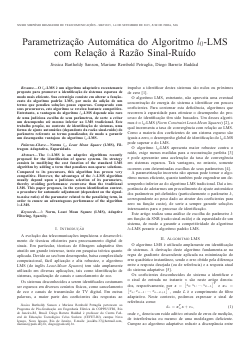
Parametrização Automática do Algoritmo l0-LMS com Relação à Razão Sinal-Ruído
Jéssica Bartholdy Sanson, Mariane Rembold Petraglia, Diego Barreto Haddad
DOI: 10.14209/sbrt.2015.150
Keywords: Norm Least Mean Square (LMS) Adaptive Filtering Sparsity
Abstract
The l0-LMS is an adaptive algorithms recently proposed for the identification of sparse systems. Its strategy consists in modifying the cost function of the standard LMS algorithm by adding a term that penalizes non-sparse solutions. Compared to its precursors, this algorithm has proven very competitive. However, the advantages of the l0-LMS algorithm usually depend upon a judicious selection of its parameters, thereby avoiding performance evenworse than the traditional LMS. This paper proposes, in the system identification context, a procedure for automatic adjustment (dependent on the signal- to-noise ratio) of the parameter related to the penalizing term, in order to ensure an advantageous performance of the algorithm l0-LMSDownload
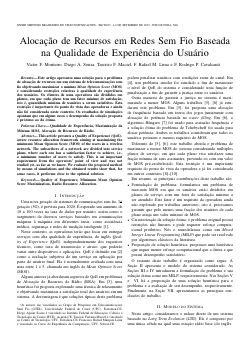
Alocação de Recursos em Redes Sem Fio Baseada na Qualidade de Experiência do Usuário
Victor F. Monteiro, Diego A. Sousa, Tarcisio F. Maciel, F. Rafael M. Lima, F. Rodrigo P. Cavalcanti
DOI: 10.14209/sbrt.2015.158
Keywords: Quality of Experience Minimum Mean Opinion Score Maximization Radio Resource Allocation
Abstract
This article presents a Quality of Experience (QoE)- aware resource allocation framework aiming at maximizing the minimum Mean Opinion Score (MOS) of the users in a wireless network. The subscribers of a network are divided into service plans, where each one has a satisfaction factor to achieve, i.e., a minimum number of users to satisfy. This is an important requirement from the operators’ point of view and was not studied yet, as far as we know. We evaluate the proposed method by means of simulations and the obtained results show that, for some cases, it performs close to the optimal solution.Download
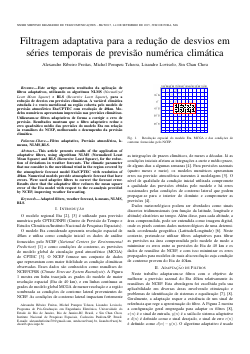
Filtragem adaptativa para a redução de desvios em séries temporais de previsão numérica climática
Alexandre Ribeiro Freitas, Michel Pompeu Tcheou, Lisandro Lovisolo, Sin Chan Chou
DOI: 10.14209/sbrt.2015.117
Keywords: Adapted filters weather forecast k-means NLMS RLS
Abstract
This article presents results of the application of adaptative filters, using algorithms NLMS (Normalized Least Mean Square) and RLS (Recursive Least Square), for the reduc- tion of deviations in weather forecasts. The climatic parameter that me consider is the meridional wind in the region covered by the atmospheric forecast model Eta/CPTEC with resolution of 40km. Numerical models provide atmospheric forecast that have errors. Were used adaptive filters to correct the forecast error. Results show that the adaptative filter reduces the mean square error of the Eta model with respect to the re-analysis provided by NCEP, improving weather forecastingDownload
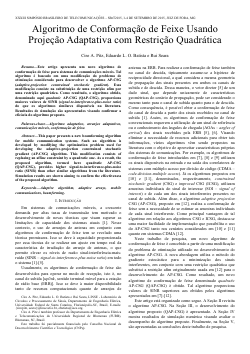
Algoritmo de Conformação de Feixe Usando Projeção Adaptativa com Restrição Quadrática
Ciro A. Pitz, Eduardo L. O. Batista, Rui Seara
DOI: 10.14209/sbrt.2015.124
Keywords: Adaptive algorithm adaptive arrays mobile communications beamforming
Abstract
This paper presents a new beamforming algorithm for mobile communication systems. Such an algorithm is developed by modifying the optimization problem used for developing the adaptive-projection constrained stochastic gradient (AP-CSG) algorithm. This modification consists of replacing an affine constraint by a quadratic one. As a result, the proposed algorithm, termed here quadratic AP-CSG (QAP-CSG), provides higher signal-to-interference-plus-noise ratio (SINR) than other similar algorithms from the literature. Simulation results are shown aiming to confirm the effectiveness of the proposed algorithmDownload

Efeito do Desbalanceamento de Clusters no Modelo η-µ
Gustavo Rodrigues de Lima Tejerina, Michel Daoud Yacoub
DOI: 10.14209/sbrt.2015.151
Keywords: η-µ modeling envelope distribution high order statistics phase crossing rate pcr.
Abstract
Higher-order statistics for the phase process of a general η-µ fading model is obtained. In particular, such statistics is derived for the case in which imbalance of multipath clusters between in-phase and quadrature signals in the η-µ fading model exists. Exact, closed-form expressions for (i) the joint probability density function of the envelope, phase, and their time derivatives and (ii) the phase crossing rate are obtained. The combined effect of power imbalance as well as multipath clustering imbalance is then explored, both for the envelope and the phase.Download

Distribuição Conjunta Fase-Envoltória Nakagami-m Bivariável
Thiago Alencar Moreira de Bairros, Michel Daoud Yacoub
DOI: 10.14209/sbrt.2015.125
Keywords: Distribuição Nakagami-m distribuição con- junta de fase e envoltória bivariável distribuição conjunta de fase
Abstract
Um modelo de desvanecimento para o sinal Nakagami-m complexo é proposto. Uma expressão exata e fechada para a função densidade de probabilidade conjunta envolvendo duas envoltórias e as duas fases correspondentes é obtida. Consideram-se os sinais com o mesmo fator de desvane- cimento mas com potências arbitrárias. O modelo proposto aqui abre uma nova área de pesquisa e é inédito na literaturaDownload

Um Novo Algoritmo Adaptativo de Posto Reduzido para Conformação de Feixe em Sistemas de Comunicações Móveis
Guilherme M. Zilli, Ciro A. Pitz, Eduardo L. O. Batista, Rui Seara
DOI: 10.14209/sbrt.2015.159
Keywords: Beamforming LCMV filter reduced rank
Abstract
This paper presents a new algorithm for beamforming in mobile communication systems. This algorithm is based on the linearly-constrained minimum-variance (LCMV) approach and also on a rank-reducing strategy. In contrast to another reduced-rank algorithm from the literature, the proposed one satisfies the unit-gain constraint of the LCMV problem regardless of the scenario and the initial conditions of the problem. Thus, adequate values of transmission power are obtained for different operating conditions, resulting in high values of signal-to-interference-plus-noise ratio at the output of the antenna array.Download
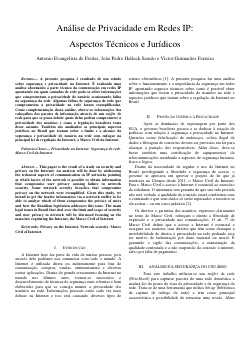
Análise de Privacidade em Redes IP: Aspectos Técnicos e Jurídicos
Antonio Evangelista de Freitas, João Pedro Hallack Sansão, Victor Guimarães Ferreira
DOI: 10.14209/sbrt.2015.168
Keywords: Privacy on the Internet Network security Marco Civil of Internet
Abstract
This paper is the result of a study on security and privacy on the Internet. An analysis will be done by addressing the technical aspects of communication in IP networks pointing at which layers of the network is possible to obtain information that compromise user privacy causing failure in network security. Some network security breaches that compromise privacy on the network were exemplified. Given this study, we intend to get the header information via a network sniffer to be able to analyse which of them compromise the privacy of users and how the Brazilian legislation addresses this issue. The main legal issues in Brazil that deal over the limit and scope of security and user privacy in network will be discussed focusing on the main law regulating the Internet, the Marco Civil of Internet.Download

Distribuição Quântica de Chave Utilizando Modulação Não Linear
Francisco Revson F. Pereira, Edmar J. Nascimento, Francisco M. Assis
DOI: 10.14209/sbrt.2015.160
Keywords: Non-linear modulation twisted modulation quan- tum key distribution quantum cryptography coherent states continuous variables
Abstract
In this article, we apply non-linear modulation techniques to continuous variables quantum key distribution protocols. More specifically, we try to relate the interference of spying the quantum channel to the probability of anomaly defined in non-linear modulation schemes. In this way, the probability of anomaly can be used to quantify the spy’s knowledge of the transmitted information.Download
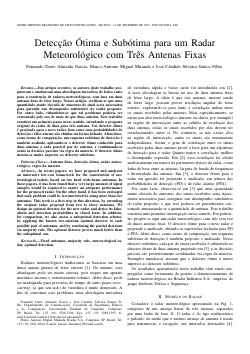
Detecção Ótima e Subótima para um Radar Meteorológico com Três Antenas Fixas
Fernando Dário Almeida García, Marco Antonio Miguel Miranda, José Candido Silveira Santos Filho
DOI: 10.14209/sbrt.2015.169
Keywords: Fixed antennas majority rule meteorological ra- dar optimal detection
Abstract
In recent papers, we have proposed and analyzed an innovative low-cost framework for the construction of me- teorological radars, based on two fixed wide-beam antennas. In those papers, it has been found that a very large amount of signal samples would be required to ensure an adequate performance for the proposed radar. On the other hand, it has been envisaged that such problem could be circumvented by using more than two antennas. This work is a first step in this direction, by extending the original radar proposal from two to three antennas. We design an optimal detector for the new radar and derive its false- alarm and detection probabilities in closed form. In addition, for comparison, we also assess a suboptimal detection scheme, by applying the known two-antenna optimal detector to each possible pair of antennas, and by combining the partial decisions via majority rule. The optimal detector proves much better than the suboptimal one.Download